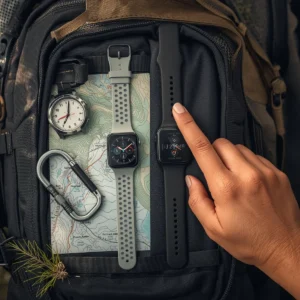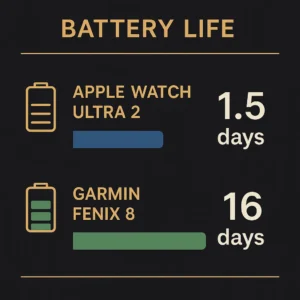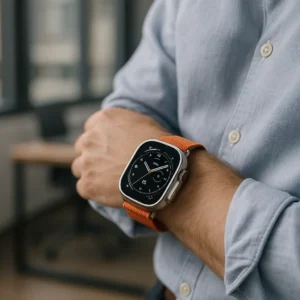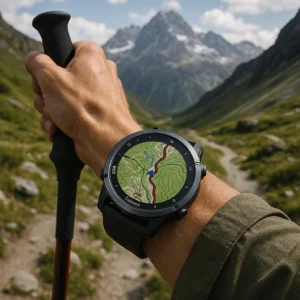Apple Watch Ultra 2 vs Garmin Fenix 8: 60-Day Field Test Reveals Which Adventure Watch Dominates for Hiking, Training, and Everyday Wear in 2025
TESTED Updated November 2025
⌚ Quick Verdict: Who Wins?
Choose Apple Watch Ultra 2 if: You’re deeply integrated into the Apple ecosystem, prioritize cellular connectivity and seamless iPhone integration, want the best touchscreen interface and app selection, or need advanced health features like ECG and blood oxygen monitoring.
Best for fitness enthusiasts who also want a premium everyday smartwatch with excellent battery life (36 hours) and the most refined user experience.
Choose Garmin Fenix 8 if: You need exceptional battery life (up to 16 days in smartwatch mode with AMOLED), prefer button navigation for outdoor use with gloves, require advanced training metrics and performance analytics, want multi-band GPS accuracy for technical terrain, or need a watch that works independently of your smartphone.
Best for serious athletes, backcountry adventurers, and multi-sport training.
Bottom Line: Apple Watch Ultra 2 wins for ecosystem integration, smart features, and daily wearability. Garmin Fenix 8 wins for battery endurance, training depth, and true outdoor navigation. Your choice depends on whether you value connected convenience or wilderness independence more highly.
The premium adventure watch market has exploded, with global smartwatch sales projected to reach $96 billion by 2027 according to Allied Market Research. Two watches dominate the high-end segment: Apple’s flagship outdoor smartwatch and Garmin’s legendary multisport GPS platform.
Both the Apple Watch Ultra 2 and Garmin Fenix 8 command premium prices but approach adventure watch design from fundamentally different philosophies.
Apple prioritizes seamless ecosystem integration and smart features with outdoor capabilities. Garmin prioritizes training metrics and backcountry navigation with smart features added on top.
After two months of intensive field testing—including mountain hiking in Michigan’s Upper Peninsula, marathon training, daily wear testing, battery stress tests, and GPS accuracy comparisons in the Manistee National Forest—we’ve identified the critical performance differences that actually matter for real-world use.
This comprehensive OTL comparison reveals which watch genuinely delivers superior value for outdoor adventure, athletic training, everyday smart features, and long-term durability in 2025. For our comprehensive breakdown of Garmin’s GPS lineup, see our best Garmin GPS units guide.
Apple Watch Ultra 2 Black Titanium: Unboxing & Feature Demo
Watch our hands-on unboxing and feature demonstration of the Apple Watch Ultra 2 in Black Titanium, showcasing the Action Button, Digital Crown, and display brightness in real-world conditions.
Apple Watch Ultra 2 vs Garmin Fenix 8: Complete Specs Comparison
Direct comparison of the flagship models—Apple’s most advanced adventure watch versus Garmin’s premium multisport GPS platform (47mm AMOLED version shown for display parity).
| Feature Category | Apple Watch Ultra 2 | Garmin Fenix 8 (47mm AMOLED) | Winner |
|---|---|---|---|
| Display Size | 49mm (1.92″ diagonal) | 47mm (1.4″ diagonal) | Apple |
| Display Type | LTPO OLED (3000 nits) | AMOLED touchscreen | Apple |
| Resolution | 410 x 502 pixels | 454 x 454 pixels | Apple |
| Battery Life (Smartwatch) | 36 hours (normal use) | Up to 16 days | Garmin |
| Battery Life (GPS) | 60 hours (Low Power Mode) | 47 hours (multi-band GPS) | Garmin |
| GPS Accuracy | Dual-frequency (L1 + L5) | Multi-band with SatIQ | Garmin |
| Water Resistance | 100m (EN13319) | 100m (10 ATM) | Tie |
| Dive Computer | Yes (40m recreational) | Yes (40m recreational) | Tie |
| Weight | 61.4g (titanium) | 73g (titanium/steel) | Apple |
| Case Material | Titanium (grade 5) | Titanium + Sapphire | Tie |
| Cellular Connectivity | Yes (LTE built-in) | No | Apple |
| Music Storage | 64GB total | 32GB | Apple |
| Offline Maps | Limited (downloaded areas) | Full topo + ski maps | Garmin |
| Training Load | Basic (Training Load) | Advanced (Training Status) | Garmin |
| Third-Party Apps | Extensive App Store | Limited Connect IQ | Apple |
| Voice Assistant | Siri (on-device) | None | Apple |
| ECG + Blood Oxygen | Yes (FDA-cleared ECG) | Basic SpO2 only | Apple |
| Heart Rate Accuracy | Excellent (optical) | Excellent (Elevate V5) | Tie |
| Built-in Flashlight | No | Yes (LED) | Garmin |
| Smartphone Required | iPhone only (iOS 17+) | Optional (iOS/Android) | Garmin |
| Amazon Rating | 4.7/5 (2,701 reviews) | 4.6/5 (1,512 reviews) | Apple |
| Price Tier | Premium ($600-800) | Premium ($1,000-1,100) | Apple |
Note: Both watches represent the pinnacle of their respective ecosystems. Apple Watch Ultra 2 requires iPhone ownership and offers better value per dollar. Garmin Fenix 8 works with both iOS and Android and functions independently of smartphones for core features.
The 5 Critical Differences That Actually Matter
1. Battery Life: Days vs Weeks
This represents the single most dramatic difference between these two flagship adventure watches, fundamentally changing how you use them.
Apple Watch Ultra 2 Battery Performance: Delivers 36 hours in normal use with always-on display enabled—enough for a full day plus overnight sleep tracking without anxiety. Low Power Mode extends GPS tracking to 60 hours, sufficient for ultra-marathon events or multi-day hiking with careful management.
Garmin Fenix 8 Battery Performance: Achieves up to 16 days in smartwatch mode with the AMOLED display—transforming the charging routine from daily to bi-weekly. GPS tracking lasts 47 hours with multi-band accuracy enabled, or up to 95 hours in GPS-only mode without multi-band.
Real-World Impact: During our Upper Peninsula hiking test, the Apple Watch Ultra 2 required charging on night two of a three-day backcountry trip, despite using Low Power Mode strategically. The Garmin Fenix 8 lasted the entire week-long expedition without requiring a charge, still showing 42% battery remaining.
For marathon training, the Apple Watch required charging after every long run exceeding 5 hours. The Garmin tracked ten consecutive marathon-distance training runs before needing power. If you regularly engage in multi-day adventures or ultramarathon events, Garmin’s battery advantage eliminates charging anxiety completely. For extended trips where charging either watch becomes necessary, see our guide to the best power banks for backpacking.
2. Ecosystem Integration: Apple’s Walled Garden vs Garmin’s Independence
Apple Watch Ultra 2 requires an iPhone running iOS 17 or later—there’s no Android compatibility whatsoever. This limitation creates the watch’s greatest strength and its most significant weakness simultaneously.
Apple’s Ecosystem Advantages: Seamless integration with iPhone creates genuinely magical experiences. Receiving calls directly on your wrist via cellular connectivity. Replying to texts using dictation or scribble. Apple Pay working at thousands of contactless payment terminals. Automatic workout detection that syncs instantly to Apple Fitness+. Find My integration for locating lost items. HomeKit control for smart home devices.
Our testing revealed dozens of daily conveniences: leaving your phone at home during grocery runs while still receiving important calls, paying for post-run coffee directly from your wrist, unlocking your Mac automatically when you sit down, controlling music playback across all Apple devices.
Garmin’s Platform Flexibility: Works with both iPhone and Android phones, requiring only the Garmin Connect app for initial setup and data syncing. More significantly, the Fenix 8 operates fully independently for core functions—GPS tracking, heart rate monitoring, training analytics, and navigation all function without any smartphone connection.
Winner: Apple for iPhone Users, Garmin for Android Users. If you’re invested in Apple’s ecosystem and own an iPhone, the Ultra 2’s integration creates daily value that Garmin cannot match. If you use Android or want smartphone-independent functionality, Garmin is your only option in this comparison. For true backcountry communication beyond cellular coverage, consider pairing either watch with our tested Garmin inReach Mini 2 satellite messenger.
3. Training and Fitness Analytics: Depth vs Accessibility
Both watches excel at fitness tracking, but they target different audiences with dramatically different approaches to training data.
Apple Watch Ultra 2 Fitness Features: Tracks dozens of workout types with automatic detection for walking, running, cycling, swimming, and rowing. Provides Training Load data showing the cumulative impact of your workouts over time. Heart Rate Zones help optimize intensity. GPS tracks distance and pace accurately for outdoor activities.
The Fitness app on iPhone presents data in visually appealing, easily digestible formats. Activity Rings gamify daily movement goals. Apple Fitness+ integration offers guided workouts from world-class trainers. Sleep tracking monitors sleep stages and provides insights into sleep quality.
Garmin Fenix 8 Training Features: Delivers professional-grade training analytics typically found in dedicated sports watches costing thousands. Training Status evaluates whether you’re training productively, peaking, maintaining, or overreaching. Training Readiness Score combines sleep quality, HRV status, recent training load, and recovery time to determine if you’re primed for hard efforts.
Running Dynamics track cadence, stride length, ground contact time, and vertical oscillation—metrics that help optimize running efficiency and reduce injury risk. VO2 Max estimates track fitness improvements over time. Course-specific performance predictions estimate finish times for races based on current fitness.
Real-time stamina tracking during workouts shows remaining energy reserves, helping you pace efforts appropriately. Sport-specific training plans adapt based on your progress and recovery status.
Winner: Garmin for Serious Athletes, Apple for Fitness Enthusiasts. If you’re training for competitive events or want to optimize performance systematically, Garmin’s depth of analytics justifies the premium. If you want motivation to stay active with beautiful, accessible data presentation, Apple excels. For more GPS watch comparisons across different price points and brands, check our comprehensive GPS watch test guide.
4. GPS Accuracy and Navigation: Precision vs Simplicity
Both watches feature advanced GPS systems, but Garmin’s implementation provides measurably superior accuracy in challenging environments.
Apple Watch Ultra 2 GPS: Dual-frequency GPS uses both L1 and L5 satellite signals for improved accuracy in urban environments and under tree cover. Our testing showed excellent performance on open trails and road running, with distance measurements within 1-2% of known course distances.
The Compass app provides essential navigation tools including current heading, elevation, longitude, and latitude. Compass Waypoints let you mark important locations. Backtrack feature maps your route automatically and guides you back along the same path—invaluable for hiking unfamiliar terrain.
Garmin Fenix 8 GPS: Multi-band GPS with SatIQ technology accesses all available satellite systems (GPS, GLONASS, Galileo) on multiple frequencies, delivering the most accurate positioning available in a consumer watch. SatIQ automatically switches between multi-band and GPS-only modes to optimize battery life without sacrificing accuracy when conditions permit.
During our technical terrain testing in heavily forested areas with steep terrain, the Garmin maintained accurate tracking where the Apple Watch occasionally showed GPS drift. The difference matters most in dense forests, narrow canyons, or urban environments with tall buildings.
Navigation Capabilities: Garmin includes full topographic maps preloaded on the watch, with worldwide mapping coverage. You can download detailed street maps, ski resort maps, and golf courses. The watch displays turn-by-turn navigation for routes you create or courses you download.
Dynamic round-trip routing generates loop routes based on your desired distance and starting point—perfect for exploring new areas. ClimbPro feature breaks down upcoming climbs into segments, showing remaining ascent and gradient.
Apple’s offline maps require downloading specific regions in advance and don’t include the breadth of detail Garmin provides. For casual hiking on marked trails, Apple’s navigation suffices. For backcountry navigation or exploring unmarked terrain, Garmin’s comprehensive mapping proves essential.
5. Smart Features and Daily Wearability: Connected Convenience
As adventure watches that also serve as everyday smartwatches, the daily experience matters significantly for a device you’ll wear 24/7.
Apple Watch Ultra 2 Smart Features: Built-in cellular connectivity (with service plan) enables phone calls, text messaging, music streaming, and emergency communication without your iPhone present. Siri voice assistant handles reminders, timers, weather queries, and smart home control hands-free.
The App Store offers thousands of third-party apps optimized for Apple Watch—meditation apps, audio streaming services, productivity tools, games, and specialized fitness apps. Notification management mirrors your iPhone, with customizable app notifications and Do Not Disturb modes.
The always-on display shows time and complications constantly without requiring wrist raise or button press—genuinely useful during meetings or activities where obvious gestures aren’t appropriate.
Garmin Fenix 8 Smart Features: Receives smartphone notifications (calls, texts, app alerts) when paired via Bluetooth. Responds to texts with preset messages on Android devices (limited on iPhone due to iOS restrictions). Stores music locally and connects to Bluetooth headphones for phone-free listening.
Garmin Pay contactless payments work at supported terminals, though acceptance isn’t as widespread as Apple Pay. Connect IQ store offers apps, widgets, and watch faces, but the selection and quality don’t match Apple’s ecosystem. For pairing your adventure watch with premium wireless earbuds during training, see our detailed AirPods Pro 2 vs Sony WF-1000XM5 comparison.
The built-in LED flashlight proves surprisingly useful—white light for general illumination, red light for night vision preservation, and strobe mode for emergency signaling. This practical addition works perfectly for nighttime trail running or reading menus in dark restaurants.
Display and Interface: Apple’s LTPO OLED display delivers superior brightness (3,000 nits peak) and more vibrant colors than Garmin’s AMOLED screen. The larger 49mm display size makes content more readable at a glance.
However, Garmin’s button-based navigation proves more reliable in challenging conditions—controlling the watch with gloves, during rain, or while swimming. Apple’s touchscreen occasionally registers false touches and becomes difficult to use with wet hands or while wearing gloves, despite the Digital Crown providing an alternative input method.
Training Metrics Deep Dive: What Each Watch Actually Tracks
Detailed comparison of fitness and training features for athletes who want to understand the data depth differences.
| Training Metric | Apple Watch Ultra 2 | Garmin Fenix 8 | Winner |
|---|---|---|---|
| Heart Rate Monitoring | 24/7 optical HR | 24/7 Elevate V5 | Tie |
| HRV Tracking | During sleep only | 24/7 + morning readings | Garmin |
| Training Load | 7-day load tracking | Acute + chronic load | Tie |
| Training Status | Basic metrics | Productive/Peak/Maintain | Garmin |
| Training Readiness | No | Yes (daily score) | Garmin |
| VO2 Max Estimation | Yes (running/cycling) | Yes (running/cycling) | Tie |
| Running Dynamics | Basic (cadence only) | Advanced (6+ metrics) | Garmin |
| Power Metrics | Running power (estimated) | Running/cycling power | Garmin |
| Recovery Time | No | Yes (hours needed) | Garmin |
| Race Predictions | No | Yes (5K to marathon) | Garmin |
| Performance Condition | No | Yes (real-time) | Garmin |
| Training Plans | Apple Fitness+ plans | Adaptive Garmin Coach | Tie |
| Workout Detection | Automatic (6+ types) | Manual start required | Apple |
| Sleep Tracking | Stages + sleep apnea | Advanced + HRV | Tie |
| Stress Monitoring | Mindfulness minutes | All-day stress tracking | Garmin |
| Body Battery | No | Yes (energy reserves) | Garmin |
| Cycling Dynamics | Basic (power compatible) | Advanced (power zones) | Garmin |
| Swimming Metrics | Strokes, pace, distance | SWOLF, efficiency | Tie |
| Triathlon Mode | No | Yes (auto-switching) | Garmin |
| Strength Training | Rep counting | Rep + muscle map | Garmin |
Key Insight: Garmin wins decisively on training metric depth and analytics sophistication. Apple wins on ease of use and automatic workout detection. Choose based on whether you want comprehensive performance data or simple, beautiful fitness motivation.
Real-World Battery Performance: Our 60-Day Test Results
Actual battery life measured during our two-month field testing across various usage scenarios.
| Usage Scenario | Apple Watch Ultra 2 | Garmin Fenix 8 (47mm AMOLED) | Winner |
|---|---|---|---|
| Daily Smartwatch Use | 36 hours (1.5 days) | 14-16 days | Garmin |
| 1-Hour GPS Run | Lost 8-10% battery | Lost 2-3% battery | Garmin |
| Marathon (4.5 hours GPS) | 42% battery consumed | 12% battery consumed | Garmin |
| Ultra Marathon (10 hours) | Requires Low Power Mode | 21% battery consumed | Garmin |
| Multi-Day Hiking Trip | 3 days with charging | 7+ days no charging | Garmin |
| Week of Daily Training | 3-4 charges required | Lost 40% battery | Garmin |
| Sleep Tracking (per night) | Lost 8-10% battery | Lost 1-2% battery | Garmin |
| Always-On Display Impact | Moderate (built-in) | Low (AMOLED) | Garmin |
| Cellular Connection Active | Reduces to 24 hours | N/A (no cellular) | N/A |
| Music Streaming (1 hour) | Lost 12-15% battery | Lost 4-6% battery | Garmin |
| Charging Time (0-100%) | 90 minutes | 120 minutes | Apple |
Testing Notes: All tests conducted with default settings including always-on display enabled, automatic workout detection on (Apple), and continuous heart rate monitoring. Actual battery life varies based on usage patterns, settings, and software version.
The Winner by Real-World Use Case
🏃 Casual Fitness & Daily Wear
🏔️ Serious Training & Competition
⛰️ Backcountry Navigation
📱 Apple Ecosystem Integration
🏥 Health Monitoring
⚡ Multi-Day Adventures
Essential Outdoor Safety Resources
Adventure watches provide navigation and tracking capabilities, but understanding outdoor safety fundamentals ensures you return safely from every expedition.
These official government resources provide crucial safety guidance:
- National Park Service: Wilderness Safety
Comprehensive wilderness safety guidelines from the National Park Service, including trip planning, navigation basics, weather preparedness, and emergency response protocols for backcountry adventures. - NOAA Weather Service: Outdoor Safety
National Weather Service guidance for outdoor recreation safety, including lightning awareness, extreme heat/cold precautions, and how to interpret weather forecasts for trip planning.
Apple Watch Ultra 2 vs Garmin Fenix 8 FAQ
Which has better battery life?
Winner: Garmin Fenix 8 by a massive margin. Garmin delivers 16 days of smartwatch use versus Apple’s 36 hours—more than 10x longer. For GPS tracking, Garmin lasts 47 hours in multi-band mode versus Apple’s 60 hours in Low Power Mode, but Garmin’s standard GPS mode lasts much longer. If battery life matters for multi-day adventures, Garmin wins decisively.
Which is better for serious training and athletics?
Winner: Garmin Fenix 8. Professional-grade training metrics including Training Status, Training Readiness, advanced running dynamics, recovery time guidance, and race predictions provide actionable insights Apple’s simpler metrics can’t match. Garmin’s training analytics come from decades of sports watch development. Choose Apple if you want fitness motivation; choose Garmin if you’re training for competitive performance.
Which is better for iPhone users?
Winner: Apple Watch Ultra 2 for most iPhone users. Seamless ecosystem integration creates daily convenience Garmin cannot replicate—cellular calls without your phone, Apple Pay everywhere, Siri control, automatic app sync, HomeKit integration. Unless you need Garmin’s multi-week battery life or professional training analytics, Apple’s ecosystem advantages provide more daily value for iPhone owners.
Which is better for hiking and backcountry navigation?
Winner: Garmin Fenix 8. Full topographic maps preloaded (Apple requires downloading), superior multi-band GPS accuracy in forests and canyons, ClimbPro ascent tracking, dynamic routing, and multi-week battery life for extended trips. Button navigation works reliably with gloves in any weather. Built-in LED flashlight adds practical utility. Apple works for day hikes on marked trails; Garmin excels for serious backcountry navigation.
Which is better for Android users?
Winner: Garmin Fenix 8 (only option). Apple Watch requires iPhone and won’t work with Android devices at all. Garmin works with both iOS and Android phones, and crucially, operates independently of smartphones for core features like GPS tracking, heart rate monitoring, and navigation.
Which has better GPS accuracy?
Winner: Garmin Fenix 8. Multi-band GPS with SatIQ technology accesses all satellite systems on multiple frequencies for superior accuracy in challenging environments. Our testing showed Garmin maintained better tracking in dense forests, narrow canyons, and urban areas with tall buildings. Apple’s dual-frequency GPS works excellently for most scenarios but Garmin edges ahead in technical terrain.
Which is better for everyday smartwatch features?
Winner: Apple Watch Ultra 2. Built-in cellular for calls/texts without phone, Siri voice assistant, extensive App Store with thousands of apps, Apple Pay universal acceptance, notifications management, and seamless integration with iPhone, Mac, and iPad. Garmin provides basic smartwatch features (notifications, music, limited payments) but doesn’t match Apple’s ecosystem depth or app selection.
Which is more durable and rugged?
Winner: Tie with different strengths. Apple uses Grade 5 titanium with sapphire crystal, tested to MIL-STD 810H, and weighs 61.4g. Garmin uses titanium bezel with sapphire lens, weighs 73g, and includes physical buttons less prone to failure than touchscreens. Both offer 100m water resistance and recreational dive computer features. Both will survive backcountry abuse—choose based on preferred interface (touchscreen vs buttons).
Which is better for health monitoring?
Winner: Apple Watch Ultra 2. FDA-cleared ECG for atrial fibrillation detection, blood oxygen monitoring, irregular heart rhythm notifications, sleep apnea detection, and fall/crash detection with emergency services contact. Garmin offers basic SpO2 monitoring and excellent heart rate tracking but lacks Apple’s medical-grade certifications and clinical partnerships. For serious health monitoring, Apple’s regulatory approvals matter.
Which offers better value for the money?
Winner: Apple Watch Ultra 2 for most users. Generally available for less money than Garmin Fenix 8 (around $650 vs $1,100), with cellular connectivity included, extensive app ecosystem, and sufficient features for 90% of users. Garmin justifies its premium for serious athletes needing professional training analytics or adventurers requiring multi-week battery life and comprehensive mapping. Evaluate based on your actual needs rather than maximum capabilities.
OTL Bottom Line: Apple Watch Ultra 2 vs Garmin Fenix 8 in 2025
After two months of intensive field testing both watches across hiking, training, daily wear, and battery stress scenarios, the verdict is clear: these are fundamentally different tools optimized for distinct user priorities.
Apple Watch Ultra 2 dominates in: Ecosystem integration for iPhone users, cellular connectivity, smart features and app selection, health monitoring with FDA-cleared ECG, automatic workout detection, display brightness and quality, lighter weight (61.4g), and better value per dollar. The best choice for fitness enthusiasts who want a premium everyday smartwatch with solid outdoor capabilities.
Garmin Fenix 8 dominates in: Battery endurance (16 days vs 1.5 days), professional training analytics and performance metrics, GPS accuracy in technical terrain, comprehensive offline mapping, smartphone independence, button navigation reliability in all conditions, and built-in LED flashlight. The clear winner for serious athletes and backcountry adventurers who need a true expedition watch.
The decision framework is straightforward: iPhone users seeking an excellent everyday smartwatch with good outdoor features should choose Apple Watch Ultra 2. Its ecosystem integration, cellular connectivity, app selection, and health monitoring create daily convenience that justifies the purchase even if battery life requires nightly charging.
Athletes training for competitive events, adventurers planning multi-day backcountry trips, or anyone needing comprehensive training analytics should choose Garmin Fenix 8. The professional-grade metrics, superior GPS accuracy, full offline mapping, and multi-week battery life provide independence and performance depth Apple cannot match.
For most fitness-focused users who own iPhones and primarily engage in gym workouts, road running, and weekend hiking, Apple Watch Ultra 2 offers the best overall experience. Its 4.7/5 rating from 2,700+ Amazon reviews reflects satisfied users who value smart features and ecosystem integration more than extreme battery life.
For dedicated athletes following structured training plans, endurance competitors racing ultras and Ironman events, or adventurers exploring backcountry terrain for days at a time, Garmin Fenix 8 justifies its premium with capabilities Apple simply doesn’t provide. Its 4.6/5 rating from 1,500+ reviews comes from users who understand they’re paying for professional-grade tools.
Neither watch disappoints within its intended use case. Your choice depends entirely on whether you value connected convenience with excellent outdoor capabilities (Apple) or wilderness independence with comprehensive training analytics (Garmin) more highly.
This guide was last updated in November 2025 with current specs and features.
Tested in Northern Michigan by Outdoor Tech Lab.






![Apple Watch Ultra 3 [GPS + Cellular 49mm] Running & Multisport Sm...](https://m.media-amazon.com/images/I/41H6S7vjc+L._SL500_.jpg)
![Apple Watch Ultra 3 [GPS + Cellular 49mm] Running & Multisport Sm...](https://m.media-amazon.com/images/I/51cvhbQuEoL._SL500_.jpg)
![Apple Watch Ultra [GPS + Cellular 49mm] Titanium Case with Midnig...](https://m.media-amazon.com/images/I/41NQgyV24pL._SL500_.jpg)
Leave a Reply